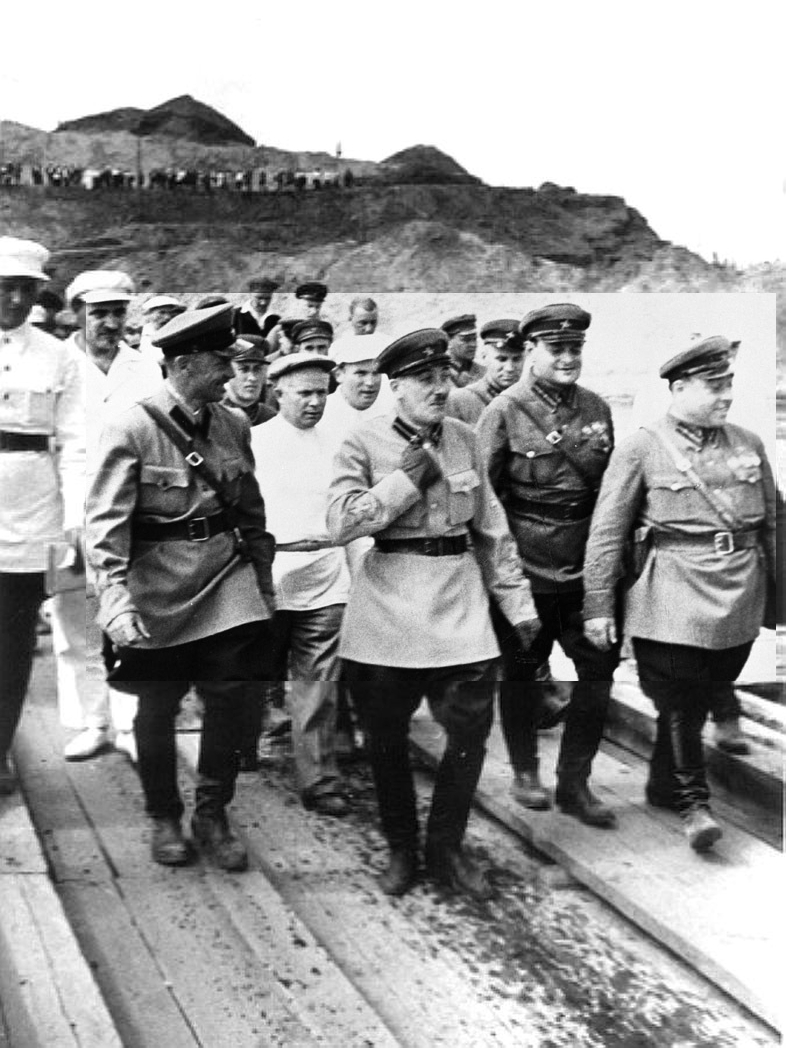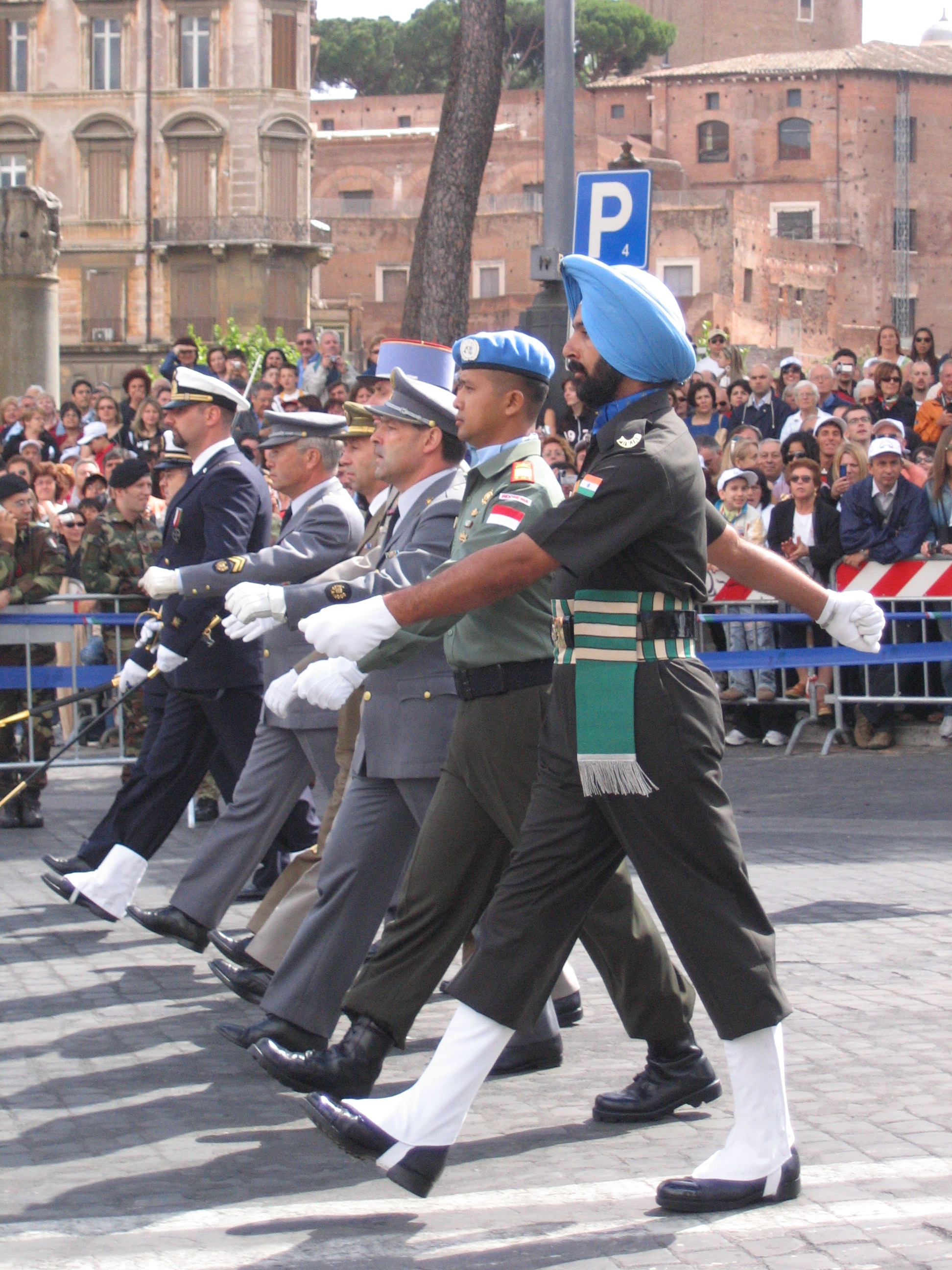|
Galliffet Trousers
Galliffet or gallifet (russian: галифе, galife) were a style of trousers in military uniform of the Soviet Army. They were similar to riding breeches, fit for jackboots. Russian dictionaries define "galife" as pants fitting the knees and below, to easily fit the ''sapogi'' (Russian jackboots), and expanding from above the knees. They were named after French general Gaston Alexandre Auguste, Marquis de Galliffet. ("From the History of Russian Uniforms") See also * |
Military Uniform
A military uniform is a standardised dress worn by members of the armed forces and paramilitaries of various nations. Military dress and styles have gone through significant changes over the centuries, from colourful and elaborate, ornamented clothing until the 19th century, to utilitarian camouflage uniforms for field and battle purposes from World War I (1914–1918) on. Military uniforms in the form of standardised and distinctive dress, intended for identification and display, are typically a sign of organised military forces equipped by a central authority. Military uniforms differ not only according to military units but tend to also be offered in different levels of formality in accordance with Western dress codes: full dress uniform for formal wear, mess dress uniform for semi-formal wear, service dress uniform for informal wear, and combat uniform (also called "battle/field dress") which would equal casual wear. Sometimes added to the casual wear category is physical t ... [...More Info...] [...Related Items...] OR: [Wikipedia] [Google] [Baidu] |
Soviet Army
uk, Радянська армія , image = File:Communist star with golden border and red rims.svg , alt = , caption = Emblem of the Soviet Army , start_date = 25 February 1946 , country = (1946–1991)' (1991–1992) , branch = , type = Army , role = Ground warfare, Land warfare , size = 3,668,075 active (1991) 4,129,506 reserve (1991) , command_structure = , garrison = , garrison_label = , nickname = "Red Army" , patron = , motto = ''За нашу Советскую Родину!(Za nashu Sovetskuyu Rodinu!)''"For our Soviet Motherland!" , colors = Red and yellow , colors_label = , march ... [...More Info...] [...Related Items...] OR: [Wikipedia] [Google] [Baidu] |
Riding Breeches
Breeches ( ) are an article of clothing covering the body from the waist down, with separate coverings for each leg, usually stopping just below the knee, though in some cases reaching to the ankles. Formerly a standard item of Western men's clothing, they had fallen out of use by the mid-19th century in favour of trousers. Modern athletic garments used for English riding and fencing, although called ''breeches'' or ''britches'', differ from breeches. Etymology ''Breeches'' is a double plural known since c. 1205, from Old English , the plural of "garment for the legs and trunk", from the Indo-European root *bhrg- "break", here apparently used in the sense "divide", "separate", as in Scottish Gaelic briogais ("trousers"), in Breton bragoù ("pants"), in Irish bríste ("trousers") and brycan/brogau in Welsh. Cognate with the Proto-Germanic word ''*brōk-'', plural ''*brōkiz'', itself most likely from the Proto-Indo-European root; whence also the Old Norse word , which shows up ... [...More Info...] [...Related Items...] OR: [Wikipedia] [Google] [Baidu] |
Jackboots
A jackboot is a military boot such as the cavalry jackboot or the hobnailed jackboot. The hobnailed jackboot has a different design and function from the first type. It is a combat boot that is designed for marching. It rises to mid-calf or higher without laces and usually has a leather sole with hobnails. Jackboots have been associated popularly with totalitarianism, as they were worn by German military and paramilitary forces during the Second World War; however, they have been used officially by other nations as well, including the United Kingdom, and had some civilian uses as well. Cavalry jackboot The term originally denoted tall "winged" leather cavalry boots, which were reinforced against sword blows by use of mail sewn into the lining of the leather. The "wings" (backward projections) on these high boots particularly protected a rider's knee-joint from a sword blow. These boots are still worn and still so termed by the Household Cavalry regiment of the British Army, initia ... [...More Info...] [...Related Items...] OR: [Wikipedia] [Google] [Baidu] |
Sapogi
A jackboot is a military boot such as the cavalry jackboot or the hobnailed jackboot. The hobnailed jackboot has a different design and function from the first type. It is a combat boot that is designed for marching. It rises to mid-calf or higher without laces and usually has a leather sole with hobnails. Jackboots have been associated popularly with totalitarianism, as they were worn by German military and paramilitary forces during the Second World War; however, they have been used officially by other nations as well, including the United Kingdom, and had some civilian uses as well. Cavalry jackboot The term originally denoted tall "winged" leather cavalry boots, which were reinforced against sword blows by use of mail sewn into the lining of the leather. The "wings" (backward projections) on these high boots particularly protected a rider's knee-joint from a sword blow. These boots are still worn and still so termed by the Household Cavalry regiment of the British Army, init ... [...More Info...] [...Related Items...] OR: [Wikipedia] [Google] [Baidu] |
Jackboot
A jackboot is a military boot such as the cavalry jackboot or the hobnailed jackboot. The hobnailed jackboot has a different design and function from the first type. It is a combat boot that is designed for marching. It rises to mid-calf or higher without laces and usually has a leather sole with hobnails. Jackboots have been associated popularly with totalitarianism, as they were worn by German military and paramilitary forces during the Second World War; however, they have been used officially by other nations as well, including the United Kingdom, and had some civilian uses as well. Cavalry jackboot The term originally denoted tall "winged" leather cavalry boots, which were reinforced against sword blows by use of mail sewn into the lining of the leather. The "wings" (backward projections) on these high boots particularly protected a rider's knee-joint from a sword blow. These boots are still worn and still so termed by the Household Cavalry regiment of the British Army, initia ... [...More Info...] [...Related Items...] OR: [Wikipedia] [Google] [Baidu] |
Gaston Alexandre Auguste, Marquis De Galliffet
Gaston Alexandre Auguste, Marquis de Galliffet, Prince de Martigues (Paris, 23 January 1830 – 8 July 1909), was a French general, best known for having taken part in the repression of the 1871 Paris Commune. He was Minister of War in Waldeck-Rousseau's cabinet at the turn of the century, which caused a controversy in the socialist movement, since independent socialist Alexandre Millerand also took part in the same government, and was thus side by side with the ''Fusilleur de la Commune'' (the "Commune's executioner"). Military interventions and Minister of War Gaston Galliffet entered the army in 1848 and was commissioned as a sub-lieutenant in 1853. He served with distinction at the Siege of Sevastopol in 1855, in the Austro-Sardinian War of 1859, and in Algeria in 1860, after which for a time he served on the personal staff of the emperor, Napoleon III. During Napoleon III's intervention in Mexico, Galliffet displayed great gallantry in 1863 as a captain at the siege an ... [...More Info...] [...Related Items...] OR: [Wikipedia] [Google] [Baidu] |
Yagoda Kanal Moskva Volga
Yagoda is a Russian surname meaning "berry". However, there is a change in stress and thus pronunciation—the surname is stressed Яго́да, and the word for "berry" is я́года. It also may be a Russian version of the name Yehuda ( Judah). Notable people with the surname include: *Genrikh Yagoda (1891–1938), Soviet state security official *Ben Yagoda (born 1954), American professor of journalism * Myroslav Yagoda (1957–2018), Ukrainian artist See also *Jagoda Jagoda is a gender-neutral surname and feminine given name. Especially common in Poland and Croatia, it means "berry" or "strawberry" in Slavic languages. Other forms include Jahoda (Czech and Slovak), Yahoda (Ukrainian), and Yagoda (Russian). ... * Yagoda, Sri Lanka, town in Sri Lanka {{surname, Yagoda Russian-language surnames Jewish surnames ... [...More Info...] [...Related Items...] OR: [Wikipedia] [Google] [Baidu] |
Gaston Galliffet 1893
Gaston is a masculine given name of French origin and a surname. The name "Gaston" may refer to: People First name * Gaston I, Count of Foix (1287–1315) *Gaston II, Count of Foix (1308–1343) * Gaston III, Count of Foix (1331–1391) *Gaston IV, Count of Foix (1422–1472) *Gaston I, Viscount of Béarn (died circa 980) *Gaston II, Viscount of Béarn (circa 951 – 1012) *Gaston III, Viscount of Béarn (died on or before 1045) *Gaston IV, Viscount of Béarn (died 1131) *Gaston V, Viscount of Béarn (died 1170) *Gaston VI, Viscount of Béarn (1173–1214) *Gaston VII, Viscount of Béarn (1225–1290) *Gaston of Foix, Prince of Viana (1444–1470) * Gaston, Count of Marsan (1721–1743) *Gaston, Duke of Orléans (1608–1660), French nobleman * Gaston Bachelard (1884–1962), French philosopher *Gaston Balande (1880–1971), French painter and illustrator * Gaston Browne (born 1967), Antiguan politician and Prime Minister *Gaston Caperton (born 1940), American politician * Gaston ... [...More Info...] [...Related Items...] OR: [Wikipedia] [Google] [Baidu] |
Uniforms Of The Russian Armed Forces
The extensive system of uniforms of the Russian Armed Forces was inherited from the Soviet Armed Forces and modified across the years. Traditionally, the military uniforms of the Russian Armed Forces have been subdivided into parade, service dress, and field uniform roles, each with summer and winter variations, largely based on rank, season, and gender differences. Governance The specific items, rules, regulations, and duties of the uniforms which are used in the Armed Forces of the Russian Federation are determined by Ministry of Defence and ultimately by the Minister of Defence. The current effective order which governs this is: * Order of the RF Ministry of Defence No. 525 of October 9, 2020 Which replaced the following previous orders (in effect from 2015 to 2020): * Order of the RF Ministry of Defence No. 300 of June 22, 2015 (for military personnel) * Order of the RF Ministry of Defence No. 340 of June 27, 2019 (for military personnel of the Navy) * Order of t ... [...More Info...] [...Related Items...] OR: [Wikipedia] [Google] [Baidu] |
Soviet Military Uniforms
The Soviet Union,. officially the Union of Soviet Socialist Republics. (USSR),. was a transcontinental country that spanned much of Eurasia from 1922 to 1991. A flagship communist state, it was nominally a federal union of fifteen national republics; in practice, both its government and its economy were highly centralized until its final years. It was a one-party state governed by the Communist Party of the Soviet Union, with the city of Moscow serving as its capital as well as that of its largest and most populous republic: the Russian SFSR. Other major cities included Leningrad (Russian SFSR), Kiev (Ukrainian SSR), Minsk (Byelorussian SSR), Tashkent (Uzbek SSR), Alma-Ata (Kazakh SSR), and Novosibirsk (Russian SFSR). It was the largest country in the world, covering over and spanning eleven time zones. The country's roots lay in the October Revolution of 1917, when the Bolsheviks, under the leadership of Vladimir Lenin, overthrew the Russian Provisional Government that ... [...More Info...] [...Related Items...] OR: [Wikipedia] [Google] [Baidu] |






.jpg)